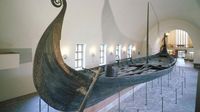In the quiet early hours of September 10, 2025, a team of archaeologists, engineers, and museum staff in Oslo, Norway, held their collective breath as one of the world’s most important Viking artifacts began its slow, final journey. The Oseberg longship—a vessel built around 1200 years ago during the height of the Viking age—was set to be moved to a new home, a feat requiring a decade of planning, a 50-ton steel cradle, and nerves of steel.
The Oseberg ship’s story began in 1903, when it was unearthed from a burial mound in Norway. According to NPR, the ship was discovered in what Jan Bill, professor of archaeology at the University of Oslo and curator of the Viking Ship Collection, described as a “remarkably well-furnished grave” with “exceptionally favorable preservation conditions.” The grave’s contents—wood, ropes, leather items—were so well preserved that, as Bill explained, “Basically all of the stuff that was put into the grave still exists today.”
The ship itself, with its elegantly curved prow and stern, intricate carvings, and mounts for shields running along the sides, became the world’s first true glimpse into what a Viking ship actually looked like. “It’s really like how we imagine the Viking ship should look like with the shields along the side of the ship,” Bill told NPR, marveling at how the Oseberg ship brought centuries-old legends to life.
But the Oseberg ship was not just a marvel of craftsmanship; it was also a vessel of mystery. Jan Bill noted, “It might have been a king, might have been a queen,” for whom the ship was built, reflecting the status and power of its original owner. The grave’s richness—its furnishings, the quality of the ship, and the preservation—suggested someone of immense importance was laid to rest there.
The find was so extraordinary that, in the early 20th century, researchers were able to reconstruct the Oseberg ship almost entirely from its original parts. About 90% of its timbers are still the same ones that once sailed the fjords and rivers of Scandinavia. For nearly a century after its discovery, the ship remained intact, a testament to both Viking craftsmanship and the skill of those who restored it.
However, as the decades passed, the ship’s luck began to turn. In the 2000s, Bill and his colleagues at the University of Oslo’s Museum of the Viking Age noticed troubling signs: small pieces of the ship were loosening and falling off. The culprit? The very air inside the museum. The building, never designed to house an artifact over a thousand years old, was unable to control humidity levels. Even the breath of thousands of visiting tourists added to the moisture, slowly but surely encouraging the ship’s deterioration.
Recognizing the threat, about ten years ago, a panel of outside experts and consultants recommended a bold solution: relocate the Oseberg ship—and its sister vessels, Tune and Gokstad—to a new, purpose-built facility. The museum embarked on a decade-long project to construct a building that could safely house these priceless relics, accommodate larger numbers of visitors, and preserve the ships for future generations.
The engineering challenge was daunting. As reported by NPR, the museum had to install a massive crane system capable of lifting and moving the delicate, ancient vessel without causing further damage. On September 10, 2025, the Oseberg ship was carefully wrapped into a steel cradle weighing 50 tons. The move itself was a feat of patience and precision: the ship traveled just 300 feet, at a glacial pace of about 10 inches per minute.
Jan Bill described the moment as unforgettable: “It was one of the most amazing moments in the time that I’ve been working as an archaeologist.” For Bill and his colleagues, the successful move was cause for celebration, but also a reminder that their work was far from over. The other two vessels in the collection, the Tune and the Gokstad ships, still await their own careful relocations to the new museum building.
The new facility, scheduled to open its doors to the public in 2027, represents more than just a safer home for the Oseberg ship. According to the University of Oslo’s Museum of the Viking Age, the building is designed to last at least two more centuries, ensuring that future generations will be able to marvel at the craftsmanship and history of the Viking age. The museum is also designed to better handle the crowds of visitors that are sure to flock to see these ancient treasures up close.
The Oseberg ship’s journey—from its construction by Viking hands, through centuries buried beneath the Norwegian earth, to its rediscovery, restoration, and now its high-tech relocation—reads like something out of a Norse saga. Each chapter has presented its own challenges and triumphs, and the story is far from over.
For the people of Norway, and for Viking enthusiasts around the world, the Oseberg ship is more than just an artifact. It’s a symbol of a seafaring culture that once dominated the North Atlantic, a tangible link to a past that still shapes the present. The intricate carvings and sturdy timbers whisper stories of adventure, power, and artistry—a reminder that history is not just something to be studied, but something to be experienced and preserved.
As preparations continue for the grand reopening in 2027, the museum’s staff remain focused on the painstaking work of preservation and education. The Tune and Gokstad ships, each with their own unique histories and mysteries, will soon join the Oseberg in their new home, completing a collection that tells the story of a people who changed the course of European history.
Looking ahead, the hope is that the new museum will not only safeguard these ships for centuries to come but also inspire new generations to explore the rich tapestry of Viking history. For now, the Oseberg ship rests in its state-of-the-art cradle, a testament to the enduring power of human ingenuity—both ancient and modern.
